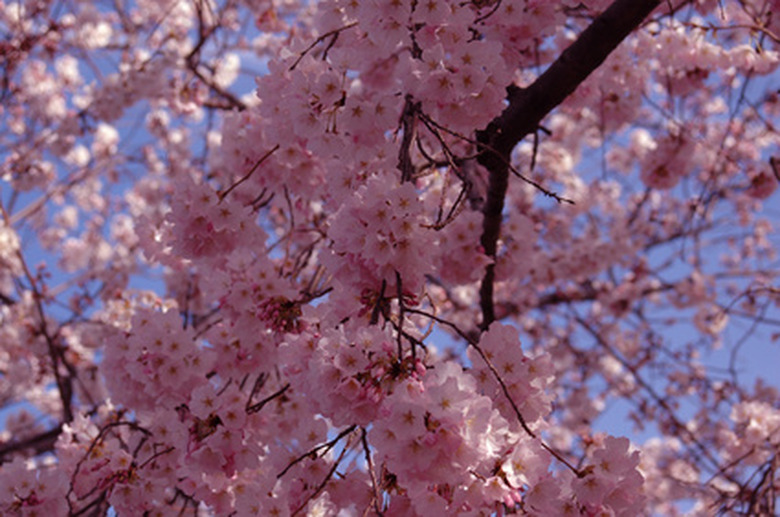Weeping Cherry Soil Conditions
The weeping cherry tree, often called the Weeping Higan Cherry, is known scientifically as Prunus subhirtella, variation 'Pendula.' It is part of the Rosaceae, or rose, family of plants. While a natural weeping form of the cherry tree exists, it produces variations that are not perceptible until the tree is old enough to bloom. For this reason many of today's trees are grown from grafted specimens, which ensures the preferred form. The weeping cherry is a graceful and beautiful addition to any landscaping project as long as its simple soil requirements are met.
Preferred Soil
Weeping cherry trees perform best in loam soil. This type of soil is generally higher in nutritive values and contains more humus or organic matter that has been broken down within the soil than most other soil types. It has relatively equal parts sand, clay and silt soil content. This is a benefit to weeping cherries because loam soil provides better water infiltration and drainage than silt soil and is easier to work than clay soils.
- The weeping cherry tree, often called the Weeping Higan Cherry, is known scientifically as Prunus subhirtella, variation 'Pendula.'
- This is a benefit to weeping cherries because loam soil provides better water infiltration and drainage than silt soil and is easier to work than clay soils.
Other Soil Types
The good news for weeping cherry tree proponents is that they are adaptable trees and will do well other types of soil including clay and sand soils. Clay soil can work to weeping cherry's advantage because of the soil's tendency to retain water, which can be critical in dry climates or during dry periods of the growing season. Weeping cherry trees planted in sandy soils will require frequent irrigation as water tends to drain away quickly in this type of soil.
More Soil Considerations
Like most cherry trees, weeping cherries prefer acidic soil with a pH value of 7 or less. Adjust the pH, if needed, by adding sulphur to the soil, aiming to change the pH level 1 point per growing season until the desired range is achieved.
Additionally, weeping cherry trees are less stressed in moist, well-drained soils. Stress can develop into disease and poor health for the tree. While they are adaptable to many soil variations, excessive periods of drought or too much water can cause problems.
- The good news for weeping cherry tree proponents is that they are adaptable trees and will do well other types of soil including clay and sand soils.
- Clay soil can work to weeping cherry's advantage because of the soil's tendency to retain water, which can be critical in dry climates or during dry periods of the growing season.
Soil Issues When Transplanting
Weeping cherries are susceptible to damage if transplanted in autumn because the tree does not have much time to adapt before going into dormancy. If this is the only available time to perform the transplant, extra care should be given to prepare the site to insure a successful transplant. Fertilizer and compost can be added to provide nutrients and a looser soil bed for young roots. The pH can be adjusted as described previously if necessary. All of these steps will enhance the soil and provide the best success potential for late season transplants.
Protecting the Soil
Soil does its job when it provides a hospitable growing environment for the pants it hosts. Soil tests every 3 to 5 years will inform you of the pH factor, which may need to be amended. Testing can also reveal any nutrient deficiencies that may need to be addressed. If the soil is sandy in nature, a good layer of mulch can help retain moisture for tree roots. Annual applications of a general purpose fertilizer can give soil a boost even if nutrients have not reached deficient levels. Follow directions and do not over fertilize.
- Weeping cherries are susceptible to damage if transplanted in autumn because the tree does not have much time to adapt before going into dormancy.
- Fertilizer and compost can be added to provide nutrients and a looser soil bed for young roots.
